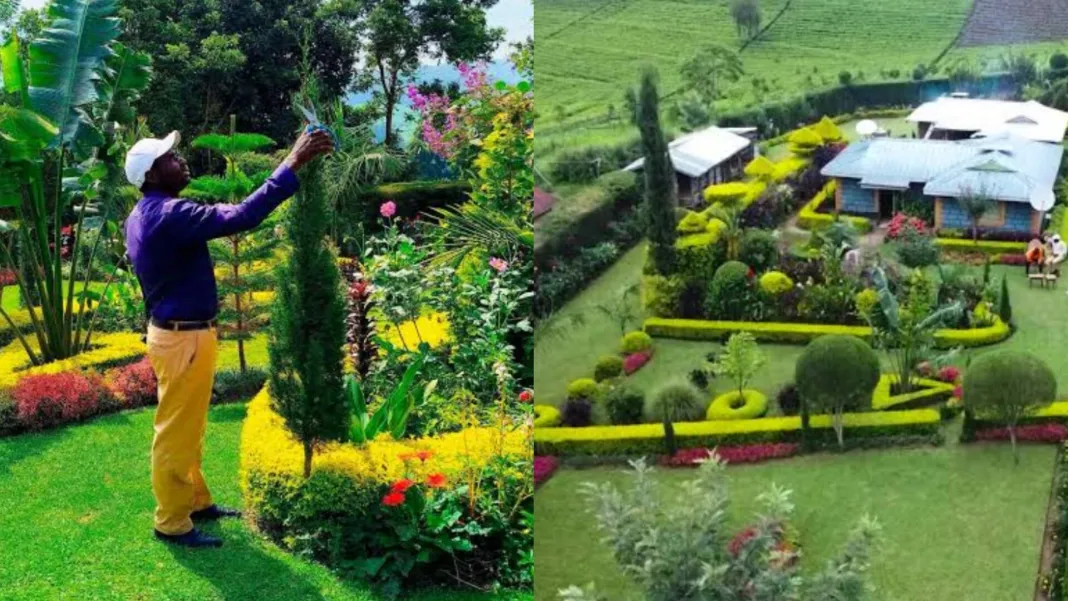When Rugut chose to uproot his maize crop and replace it with flowers and trees, many of his neighbors thought he had lost his mind. In a region where most farmers rely heavily on growing maize or tea for their daily bread, his decision seemed baffling.
But Rugut, a professional surveyor by trade, had a vision—he dreamt of transforming his land into a beautiful retirement sanctuary, rich with greenery and vibrant blooms.
“This was all maize before. When I built my house back in 2017, the land was nothing but dust and sand—there wasn’t a single blade of grass,” he recalls.
His passion for plants traces back to his childhood. Rugut’s father, despite living in a modest hut, had a deep love for native trees and managed to fill the surrounding area with flowers. That love for gardening rubbed off on Rugut.
“I’ve always been drawn to ornamental and exotic plants—that came from my dad. After college, I was surveying land for my friend Amos, who also had a nursery. He’d give me seedlings he didn’t need, and I’d plant them,” he says.
In his home village of Chematich, Rugut began planting, one tree at a time. His neighbors were skeptical, often suggesting he should’ve used the land for maize or tea. But Rugut stuck to his passion.
“In life, do what you love—not what people expect,” he says firmly.

He focused on plants that were easy to grow, visually striking, and pleasantly fragrant. Today, his half-acre garden hosts over 500 different plants.
Though small in size, the garden feels vast. The explosion of color—reds, yellows, pinks, and greens—paired with tall, wind-breaking trees, creates a vibrant, immersive space. His collection includes roses, succulents, heliconias, birds of paradise, snake plants, colored durantas, Jacob’s coat, coleus, and many more.
Most of these plants were gifts or cuttings from neighbors, which Rugut skillfully propagated.
“Many people don’t realize the beauty around them. What they dismiss as weeds could actually transform their spaces,” he points out.
The first three plants to take root in his compound were an Italian cypress, a benjamina, and a golden palm—gifts from his friend Amos. To this day, they stand tall as centerpieces in his garden.
Among the nearly 500 plants, Rugut holds a special fondness for the resilient Dahlia.
“Dahlias are my favorite. They come in so many varieties, are easy to grow, and hardly get affected by pests. I’ve learned a lot online—how to plant, organize, and design. I didn’t have a budget; it all happened bit by bit. I honestly can’t say how much I spent,” he explains.
The front yard showcases more than 50 species of flowers and plants arranged in tiered layers—upper, middle, and lower. At the top, you’ll find yellow-green duranta, a purplish-green Rugut variety in full bloom, and the giant herb-Robert stealing the show.
Instead of exotic lawns, he chose natural Kikuyu grass, native to Nandi, which now carpets the space in lush green. Blooms like Japanese spiraea, moss campion, red amaranth, and sweet William complement the natural grass beautifully.

What sets Rugut’s lawn apart is its design. Rather than leaving it plain, he created mini themed gardens within the grass, adding depth and bursts of color.
“I like curved, linear, and circular designs—they’re eye-catching and simple to maintain. I don’t have fancy turf. This Kikuyu grass just grows here naturally—I just take care of it,” he adds.
His wife and child help with watering the garden every two weeks. While pests like aphids and diseases pose a challenge, they manage them with fungicides and patience.
On weekends, the garden becomes more than a peaceful haven. Rugut opens his gates to paying guests who come to take photos and shoot videos, soaking in the tranquility and vibrant beauty of the space.



